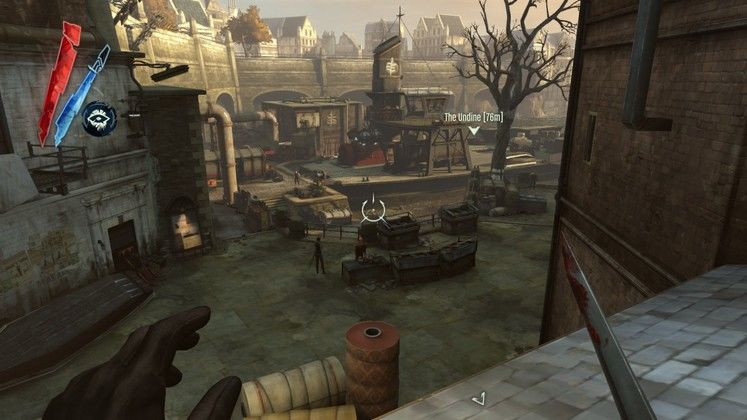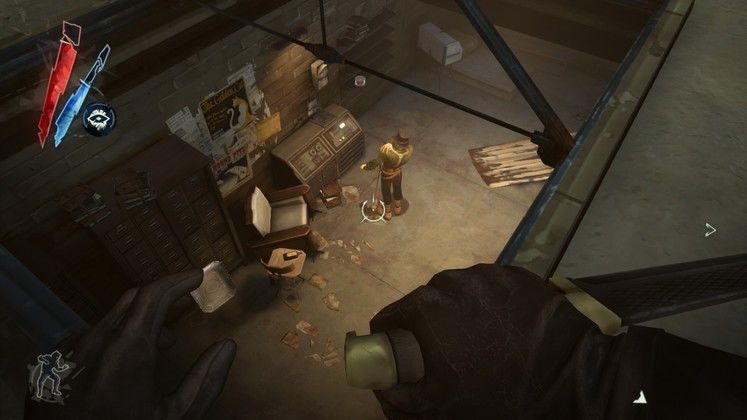First of all the great news: saves, weapons, and decisions from The Knife of Dunwall do indeed carry over. Thank the Overseer for that. I said in the last DLC’s review that this would be absolutely crucial, and thankfully Arkane have delivered with no nonsense like having to reassign your powers or anything. In terms of decisions mostly The Brigmore Witches goes off of your Chaos rating with how it adjusts to your decisions, but there is the odd callback. Written reports detailed my actions at the slaughterhouse, I could buy a favour from a worker I saved, and Nobleman Timsh (who I chose to disgrace rather than assassinate) can turn up behind bars begging for your assistance. All that’s just from one playthrough, so it’ll be intriguing to see how the game caters to different decisions.
 |
| Really, you’re going to try and stare down the world’s strongest assassin? Your funeral |
Anyway, story. Following on from Knife of Dunwall and the betrayal by one of his most trusted colleagues, Daud has discovered the location of the witch Delilah but doesn’t yet know what she’s planning. She’s holed up in Brigmore Manor on the outskirts of Dunwall, but he’ll need a ship and a crazy captain to get there. Unfortunately the only captain who’ll take him, Lizzy Stride (the vicious former boss of the Dead Eels gang), is currently incarcerated in Coldridge Prison. Cue an impromptu jailbreak.
The most interesting part of the story is that while Knife of Dunwall took place while Corvo Attano was innocently imprisoned The Brigmore Witches is after his escape from Coldridge and so is set during the events of Dishonored. Rather coolly the rebellion and Corvo’s path of terror are frequently referenced and discussed here, and while the first mission set in Coldridge Prison is reusing that location from the main game Daud gets to see the aftermath of Corvo’s daring escape. That, the heightened security and the fact that we get to see more of the prison than was in Dishonored (plus if you want you can buy a favour to impersonate a guard and just walk in) lessens the disappointment considerably.
The following levels are brand new, so that’s the other big problem of Knife of Dunwall completely sorted (where the final level was just a reverse replay of part of an old Dishonored level). Drapers Ward used to be a popular posh shopping district but is now overrun by plague, floods, and gang warfare, and has several different areas contained within. Brigmore Manor on the other hand is a glorious finale as it’s wildly different to anything yet seen in Dishonored. Green and overgrown, best of all it finally brings in the last piece of the Thief puzzle: supernatural enemies that you have to alter your tactics completely to face. No more hints than that... although it’s not zombies or chain-rattling undead Hammerites.
 |
| That boat’s going to be a pain in the arse to board. I don’t even have a ticket |
Coleridge Prison is a short but fun detour with no assassination opportunities, and the aforementioned favour that allows Daud to dress up as an Overseer and walk straight in changes your entire approach. If you’re careful you can avoid being discovered entirely, although you don’t have access to the entire prison so be careful in the restricted areas. Drapers Ward is a lot larger, and shows another excellent side of the ever-interesting Dunwall. One extra worry is if you decide to assassinate your target he’s rigged the entire area to set off a deadly gas if he dies, so you have to account for that. Another part, the infiltration of a ship lodged in a harbour, has multiple approaches and is very tricky (and fun) for the stealth or action player. It’s also made more interesting by a shadowy figure that seems to be watching the ship and has the crew on edge.
There are some slight disappointments in Drapers Ward however. For starters half the map is closed to you until you accomplish one objective, and that one objective, eliminate the usurper boss of the Dead Eels for Lizzy, does not have an imaginative end. You simply choke or stab the guy, so there’s no packing him in a shipping crate and sending him to the other side of the world like in Knife of Dunwall. That said, the areas are all well designed, lots of fun whether you’re playing action or sneaky, and have some cool choice-or-consequence moments. I can’t spoil them sadly, but they’re so seamlessly integrated most players won’t even notice some of them until they play again and do something different – then watch as a massive assault happens they could’ve prevented!
It’s Brigmore Manor that’s my favourite, and even if it’s not quite as open as I’d like there are so many ways of doing things and getting through it’s impossible to be dissatisfied. When you take into account the mysterious supernatural enemies (for Doctor Who fans, “don’t blink” is probably the best advice for one of them), rooms that can be absolutely infested with traps, and the countryside shift all makes the Manor a singularly unique chapter and a great way to send Dishonored off. The final battle with Delilah is a bit short, but the ending takes your actions into account far better than the main game’s did, leaving me absolutely satisfied when the credits rolled.
For the most part powers carry over from The Knife of Dunwall (complete with the continued sad absence of Possession) but there is a new power called Pull, and no, that doesn’t involve buying ladies drinks in a bar. If you’ve played Jedi Knight II or The Force Unleashed you know how it works, and since Force Pull was the most fun power in those games it’s gratefully welcome here. There are tweaks for the Dishonored template of course. At Level 1 you can pull items and pick them up, but Level 2 joyfully allows you to pull people and bodies at last. Yank an enemy toward you and you can either choke or kill them, or just chuck them somewhere nasty. I ended up using this power the most, I can tell you. Shame it can’t be imported into the main game. The other power-based addition is the new “Corrupted Runes” that give stronger power-ups but at a cost, like no Mana regeneration. On the whole I found these new Runes to be not worth the cost, but they’re a cute addition to the lore at least.
 |
| That Hatter’s going to get a big knife-shaped hole in his hat |
All levels tax the player regardless if they’re playing action or stealth, and I feel Brigmore Witches offer a greater challenge in both than either Dishonored or The Knife of Dunwall. Enemies dodge sword-thrusts more successfully, call reinforcements and can quickly swarm you if you just wade in. Tighter and less predictable patrols will really test the resolve of more stealthy players too. And that’s before we take Brigmore Manor into account with its range of tougher enemies and obstacles previously unseen in Dishonored, meaning that players will have to take on new tactics to beat the Manor’s challenges. It’s all excellent stuff and lots of fun no matter how you play.
Combined with The Knife of Dunwall, The Brigmore Witches and the story of Daud is exactly what Dishonored’s DLC needed to be – a fun side-story with an interesting character that adds to the main story but doesn’t take anything away. The story of Daud’s redemption is pretty well told in the few hours it takes to complete (depending as ever on your play-style), adding some full supernatural dealings to Dunwall but always keeping to the series’ intriguing canon, and ends on arguably a higher note than Dishonored itself (which always had a slightly predictable story and never really accepted non-lethal “neutralizations”). That some areas are reused from the main game was disappointing in Knife but done much better in Brigmore, and the new areas are a great mix of well-designed classic (the city-bound Drapers Ward) and the completely new (green and terrifying Brigmore Manor). Minor disappointments aside, if you enjoyed Dishonored you really need to play Daud’s story – and The Brigmore Witches is the stronger of the two-parter. Now then Arkane, about Prey 2…
Helping up a poor injured lady in the rat-infested sewers. Hang on, something’s screwy here...
DISHONORED: THE BRIGMORE WITCHES VERDICT
Combined with The Knife of Dunwall, The Brigmore Witches and the story of Daud is exactly what Dishonored’s DLC needed to be – a fun side-story with an interesting character that adds to the main story but doesn’t take anything away. The story of Daud’s redemption is pretty well told in the few hours it takes to complete (depending as ever on your play-style), adding some full supernatural dealings to Dunwall but always keeping to the series’ intriguing canon, and ends on arguably a higher note than Dishonored itself (which always had a slightly predictable story and never really accepted non-lethal “neutralizations”). That some areas are reused from the main game was disappointing in Knife but done much better in Brigmore, and the new areas are a great mix of well-designed classic (the city-bound Drapers Ward) and the completely new (green and terrifying Brigmore Manor). Minor disappointments aside, if you enjoyed Dishonored you really need to play Daud’s story – and The Brigmore Witches is the stronger of the two-parter. Now then Arkane, about Prey 2…
TOP GAME MOMENT
Helping up a poor injured lady in the rat-infested sewers. Hang on, something’s screwy here…




